Biodegradable Carbon-based Ashes/Maize Starch Composite Films for Agricultural Applications
Abstract
:1. Introduction
2. Materials and Methods
2.1. Materials
2.2. Preparation of Thermoplastic Carbon Ashes/Maize Starch Films
2.3. Rheological Characterization
2.4. Wide Angle X-ray Diffraction
2.5. Morphological Characterization
2.6. Differential Scanning Calorimetry
2.7. Thermogravimetric Analysis
- Ea is the activation energy;
- A is the Arrhenius pre-exponential factor;
- R is the gas constant (8.31 J/mol·K).
2.8. Moisture Absorption and Biodegradation Tests
2.9. Mechanical Characterization
3. Data Processing and Experimental Results
3.1. Starch and Carbon Ashes Characterization
3.2. Thermoplastic Carbon Ashes/Maize Starch Films Characterization
3.2.1. Rheology
3.2.2. Morphology
3.2.3. Thermal Stability
3.2.4. Mechanical Analysis
4. Conclusions
Author Contributions
Funding
Acknowledgments
Conflicts of Interest
References
- Vassilev, S.; Baxtera, D.; Andersen, L.K.; Vassileva, C.G. An overview of the composition and application of biomass ash: Part 2. Potential utilisation, technological and ecological advantages and challenges. Fuel 2013, 105, 19–39. [Google Scholar] [CrossRef]
- Justin Koh, J.; Zhang, X.; He, C. Fully biodegradable Poly(lactic acid)/Starch blends: A review of toughening strategies. Int. J. Biol. Macromol. 2018, 109, 99–113. [Google Scholar]
- Greco, A.; Ferrari, F.; Maffezzoli, A. Thermal analysis of poly(lactic acid) plasticized by cardanol derivates. J. Therm. Anal. 2018, 134, 559–565. [Google Scholar] [CrossRef]
- Greco, A.; Ferrari, F.; Maffezzoli, A. Mechanical properties of poly(lactic acid) plasticized by cardanol derivates. Polym. Degrad. Sased Biopolym. Nat. Fibres Tab. 2018, 159, 199–204. [Google Scholar]
- Dos Santos Rosa, D.; Lenz, D.M. Biocomposites: Influence of matrix nature and additives on the properties and biodegradation behaviour. In Biodegradation-Engineering and Technology; Chamy, R., Rosenkranz, F., Eds.; IntechOpen: London, UK, 2013. [Google Scholar]
- Garkhail, S.K.; Meurs, E.; Van De Beld, T.; Peijs, T. Thermoplastic Composites Based on Biopolymers and Natural Fibres. Available online: fdocuments.in/document/thermoplastic-composites-based-on-biopolymers-and-natural-fibres.html (accessed on 14 February 2017).
- Khalil, H.P.S.A.; Chong, E.W.N.; Owolabi, F.A.T.; Asniza, M.; Tye, Y.Y.; Rizal, S.; Nurul Fazita, M.R.; Haafiz, M.M.K.; Nurmiati, Z.; Paridah, M.T. Enhancement of basic properties of polysaccharide-based composites with organic and inorganic fillers: A review. J. Appl. Polym. Sci. 2019, 136, 47251. [Google Scholar] [CrossRef] [Green Version]
- Pareta, R.; Edirisinghe, M.J. A novel method for the preparation of starch films and coatings. Carbohydr. Polym. 2006, 63, 425–431. [Google Scholar] [CrossRef]
- Rosseto, M.; Krein, D.D.C.; Balbé, N.P.; Dettmer, A. Starch-gelatin film as an alternative to the use of plastics in agriculture: A review. J. Sci. Food Agric. 2019. [Google Scholar] [CrossRef]
- Otey, F.H.; Mark, A.M.; Mehltretter, C.L.; Russell, C.R. Starch-based film for degradable agricultural mulch. Ind. Eng. Chem. Prod. Res. Dev. 1974, 13, 90–92. [Google Scholar] [CrossRef]
- Otey, F.H.; Westhoff, R.P.; Doane, W.M. Starch-based blown films. Ind. Eng. Chem. Prod. Res. Dev. 1980, 19, 592–595. [Google Scholar] [CrossRef]
- Otey, F.H.; Westhoff, R.P.; Doane, W.M. Starch-based blown films. 2. Ind. Eng. Chem. Res. Dev. 1987, 26, 1659–1663. [Google Scholar] [CrossRef]
- Sun, T.; Li, G.; Ning, T.Y.; Zhang, Z.M.; Mi, Q.H.; Lal, R. Suitability of mulching with biodegradable film to moderate soil temperature and moisture and to increase photosynthesis and yield in peanut. Agric. Water Manag. 2018, 208, 214–223. [Google Scholar] [CrossRef]
- Bilck, A.P.; Grossmann, M.V.E.; Yamashita, F. Biodegradable mulch films for strawberry production. Polym. Test. 2010, 29, 471–476. [Google Scholar] [CrossRef]
- Dang, X.; Shan, Z.; Chen, H. The preparation and applications of one biodegradable liquid film mulching by oxidized corn starch–gelatin composite. Biotechnol. Appl. Biochem. 2016, 180, 917–929. [Google Scholar] [CrossRef]
- Merino, D.; Gutiéerrez, T.J.; Alvarez, V.A. Structural and thermal properties of agricultural mulch films based on native and oxidized corn starch nanocomposites. Starch-Stärke 2019, 71, 1800341. [Google Scholar] [CrossRef]
- Benito-González, I.; López-Rubio, A.; Martínez-Sanz, M. High-performance starch biocomposites with cellulose from waste biomass: Film properties and retrogradation behaviour. Carbohydr. Polym. 2019, 216, 180–188. [Google Scholar] [CrossRef] [PubMed]
- Ibrahim, M.I.J.; Sapuan, S.M.; Zainudin, E.S.; Zuhri, M.Y.M. Potential of using multiscale corn husk fiber as reinforcing filler in cornstarch-based biocomposites. Int. J. Biol. Macromol. 2019, 139, 596–604. [Google Scholar] [CrossRef] [PubMed]
- Collazo-Bigliardi, S.; Ortega-Toro, R.; Chiralt, A. Improving properties of thermoplastic starch films by incorporating active extracts and cellulose fibres isolated from rice or coffee husk. Food Packag. Shelf Life 2019, 22, 100383. [Google Scholar] [CrossRef]
- Sreekumar, P.A.; Haque, S.K.M.; Afzal, H.M.; Sadique, Z.; Al-Harthi, M.A. Preparation and characterization of microcellulose reinforced polyvinyl alcohol/starch biocomposites. J. Compos. Mater. 2019, 53, 1933–1939. [Google Scholar] [CrossRef]
- Torres, F.G.; Mayorga, J.P.; Vilca, C.; Arroyo, J.; Castro, P.; Rodriguez, L. Preparation and characterization of a novel starch-chestnut husk biocomposite. SN Appl. Sci. 2019, 1, 1158. [Google Scholar] [CrossRef] [Green Version]
- Stasi, E.; Giuri, A.; La Villetta, M.; Cirillo, D.; Guerra, G.; Maffezzoli, A.; Ferraris, E.; Esposito Corcione, C. Catalytic activity of oxidized carbon waste ashes for the crosslinking of epoxy resins. Polymers 2019, 11, 1011. [Google Scholar] [CrossRef] [Green Version]
- Stasi, E.; Giuri, A.; La Villetta, M.; Cirillo, D.; Guerra, G.; Maffezzoli, A.; Ferraris, E.; Esposito Corcione, C. Development and characterization of innovative carbon-based waste ashes/epoxy composites. Mater. Today Proc. 2020. manuscript accepted. [Google Scholar] [CrossRef]
- Hermans, P.H.; Weidinger, A. On the determination of the crystalline fraction of polyethylenes from X-ray diffraction. Macromol. Chem. Phys. 2003, 44, 24–36. [Google Scholar] [CrossRef]
- Mano, J.F.; Koniarova, D.; Reis, R.L. Thermal properties of thermoplastic starch/synthetic polymer blends with potential biomedical applicability. J. Mater. Sci. Mater. Med. 2003, 14, 127–135. [Google Scholar] [CrossRef] [PubMed]
- Hatakeyama, T.; Quinn, F.X. Thermal analysis: Fundamentals and Applications to Polymer Science. J. Am. Chem. Soc. 1996, 118, 5334. [Google Scholar]
- Soliman, A.A.A.; El-Shinnawy, N.A.; Mobarak, F. Thermal behaviour of starch and oxidized starch. Thermoch. Acta 1997, 296, 149–153. [Google Scholar] [CrossRef]
- Broido, A. A simple, sensitive graphical method of treating thermogravimetric analysis data. J. Polym. Sci. A-2 1968, 7, 1761. [Google Scholar] [CrossRef]
- ASTM D882-97: Standard Test Method for Tensile Properties of Thin Plastic Sheeting. Available online: mahshahr.aut.ac.ir/lib/exe/fetch.php?media=labs:astm_d882.pdf (accessed on 8 June 2019).
- Giuri, A.; Collella, S.; Listorti, A.; Rizzo, A.; Esposito Corcione, C. Biodegradable extruded thermoplastic maize starch for outdoor applications. J. Therm. Anal. 2018, 134, 549–558. [Google Scholar] [CrossRef]
- Greco, A.; Ferrari, F.; Del Sole, R.; Maffezzoli, A. Use of cardanol derivatives as plasticizers for PVC. J. Vinyl Addit. Technol. 2016. [Google Scholar] [CrossRef]
- Van Soest, J.J.G.; Hulleman, S.H.D.; de Wit, D.; Vliegenthart, J.F.G. Crystallinity in starch bioplastics. Ind. Crops Prod. 1996, 5, 11–22. [Google Scholar] [CrossRef] [Green Version]
- Hanna, A.A.; Basta, A.H.; El-Saied, H.; Abadir, I.F. Thermal properties of cellulose acetate and its complexes with some transition metals. Die Angewandte Makromolekulare Chemie 1998, 260, 1–4. [Google Scholar] [CrossRef]
- Kweon, D.K.; Cha, D.S.; Park, H.J.; Lim, S.T. Starch-g-polycaprolactone copolymerization using diisocyanate intermediates and thermal characteristics of the copolymers. J. Appl. Polym. Sci. 2000, 78, 986–993. [Google Scholar] [CrossRef]
- Pichaiyut, S.; Nakason, C.; Wisunthorn, S. Biodegradability and thermal properties of novel natural rubber/linear low density polyethylene/thermoplastic starch ternary blends. J. Polym. Environ. 2018, 26, 2855–2866. [Google Scholar] [CrossRef]
- Esposito Corcione, C.; Maffezzoli, A. Glass transition in thermosetting clay-nanocomposite polyurethanes. Therm. Acta 2009, 485, 43–48. [Google Scholar] [CrossRef]
- Ferrari, F.; Greco, A. Thermal analysis of self-healing thermoplastic matrix nanocomposite from cyclic butylene terephthalate. J. Therm. Anal. 2018, 134, 567–574. [Google Scholar] [CrossRef]
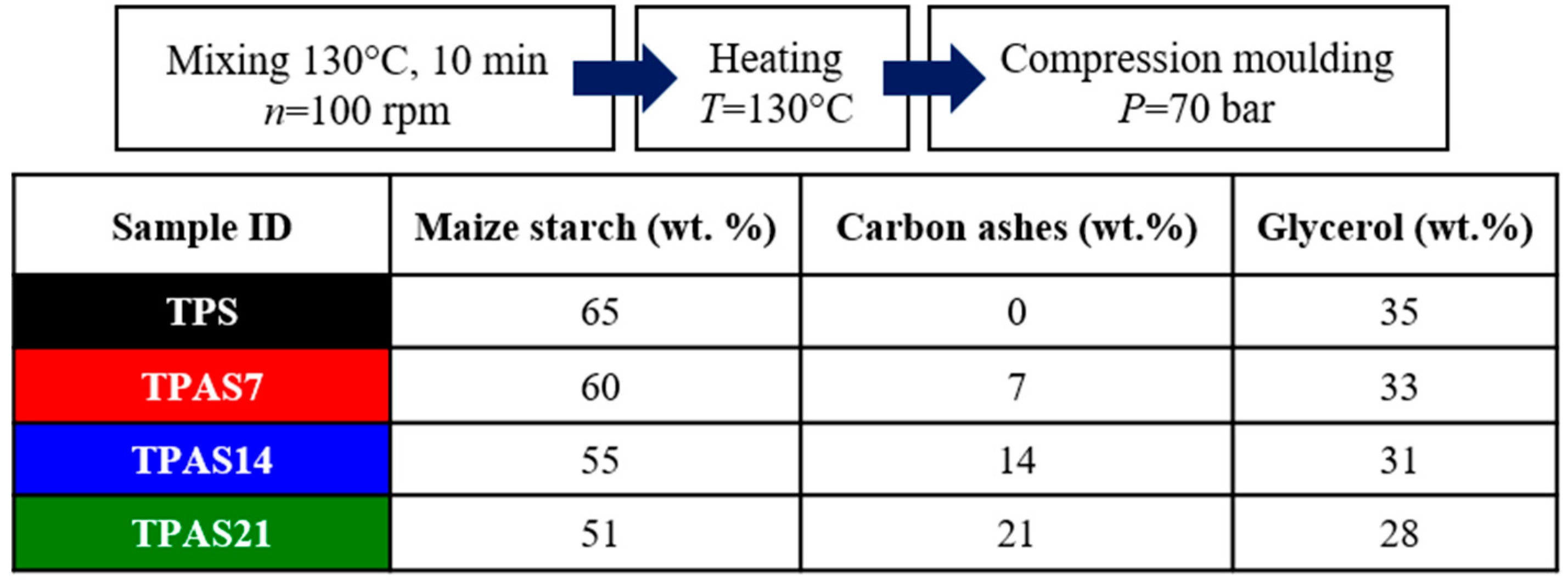
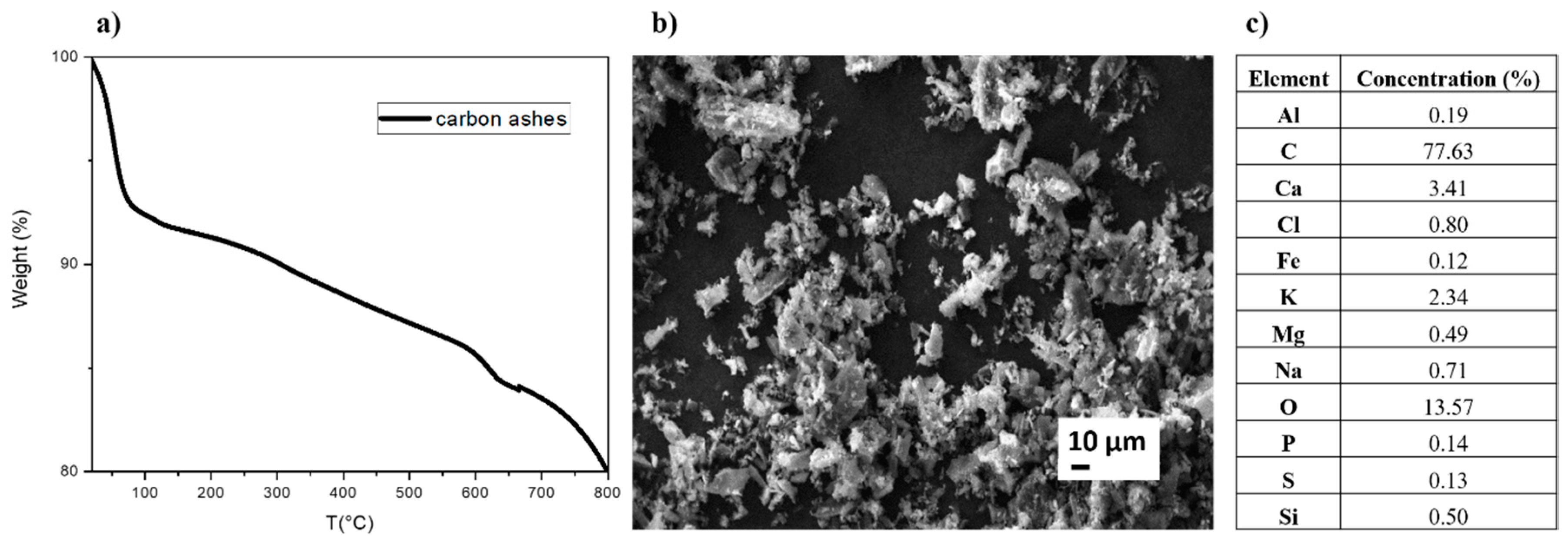


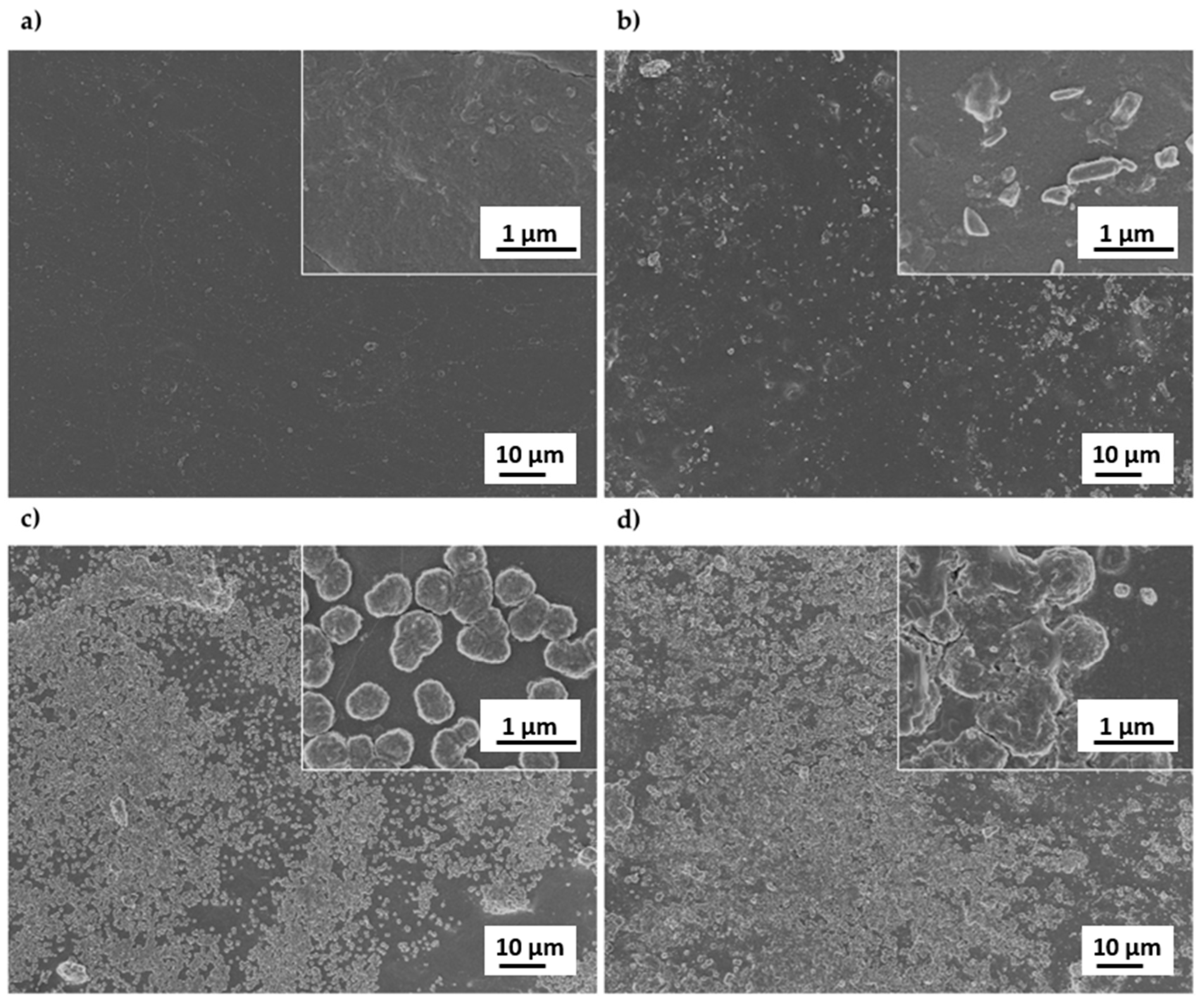
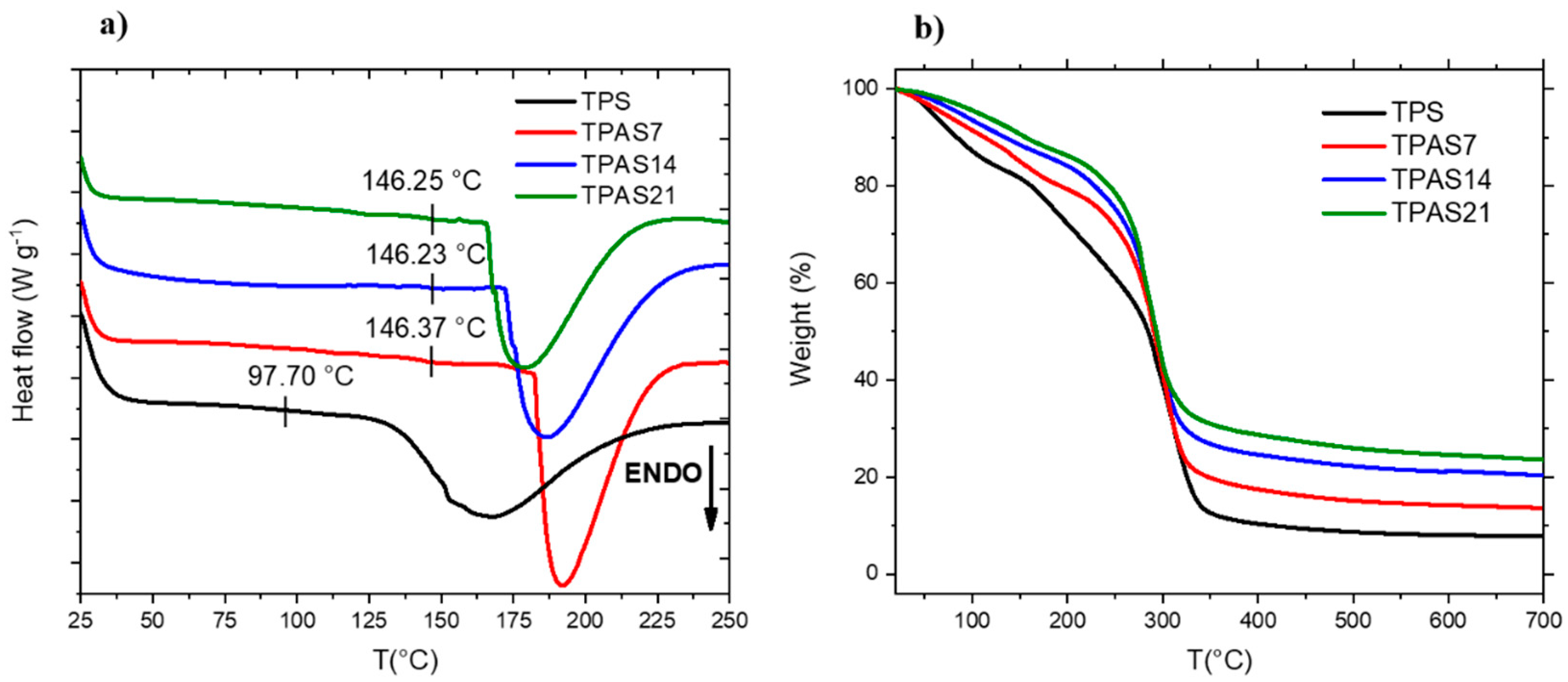



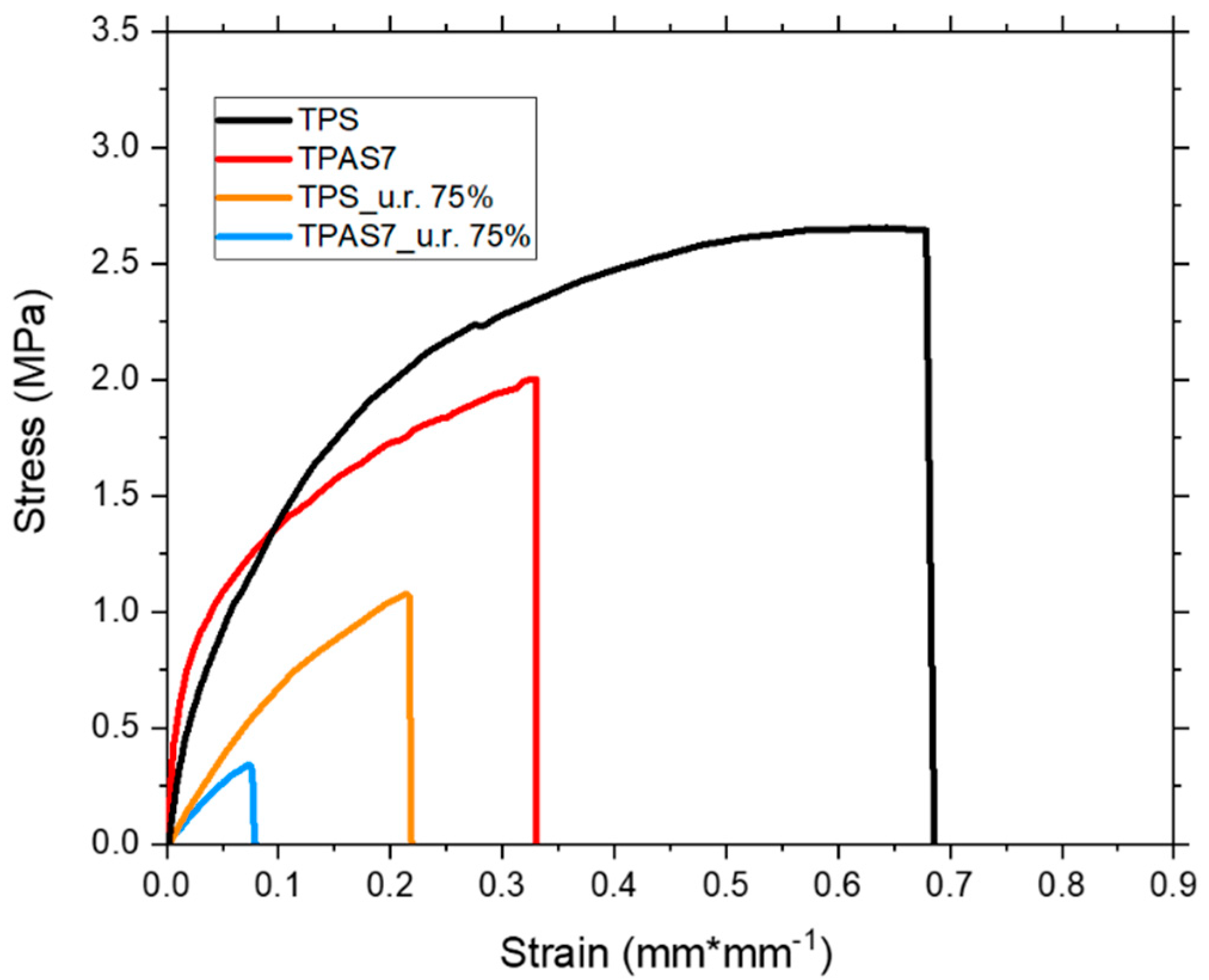
| Sample | Tg (°C) | TPEAK (°C) | ΔHm (J·g−1) | Water Loss (%) | Solid Residue (%) |
|---|---|---|---|---|---|
| TPS | 97.70 | 167.51 | 219.14 ± 1.30 | 14.96 ± 1.87 | 7.74 ± 0.07 |
| TPAS7 | 146.37 | 191.95 | 217.73 ± 0.85 | 12.03 ± 0.86 | 13.62 ± 0.13 |
| TPAS14 | 146.23 | 187.18 | 212.51 ± 2.00 | 11.54 ± 0.61 | 20.30 ± 0.19 |
| TPAS21 | 146.25 | 179.48 | 217.52 ± 3.25 | 9.30 ± 0.53 | 23.55 ± 0.11 |
| Sample | σf (MPa) | εu (mm * mm−1) | E (MPa) |
|---|---|---|---|
| TPS | 2.65 ± 0.03 | 0.66 ± 0.05 | 27.87 ± 0.91 |
| TPS_u.r. 75% | 1.08 ± 0.04 | 0.23 ± 0.01 | 8.07 ± 0.51 |
| TPAS7 | 2.27 ± 0.16 | 0.33 ± 0.03 | 32.19 ± 0.66 |
| TPAS7_u.r. 75% | 0.52 ± 0.10 | 0.07 ± 0.02 | 5.86 ± 0.49 |
© 2020 by the authors. Licensee MDPI, Basel, Switzerland. This article is an open access article distributed under the terms and conditions of the Creative Commons Attribution (CC BY) license (http://creativecommons.org/licenses/by/4.0/).
Share and Cite
Stasi, E.; Giuri, A.; Ferrari, F.; Armenise, V.; Colella, S.; Listorti, A.; Rizzo, A.; Ferraris, E.; Esposito Corcione, C. Biodegradable Carbon-based Ashes/Maize Starch Composite Films for Agricultural Applications. Polymers 2020, 12, 524. https://doi.org/10.3390/polym12030524
Stasi E, Giuri A, Ferrari F, Armenise V, Colella S, Listorti A, Rizzo A, Ferraris E, Esposito Corcione C. Biodegradable Carbon-based Ashes/Maize Starch Composite Films for Agricultural Applications. Polymers. 2020; 12(3):524. https://doi.org/10.3390/polym12030524
Chicago/Turabian StyleStasi, Enrica, Antonella Giuri, Francesca Ferrari, Vincenza Armenise, Silvia Colella, Andrea Listorti, Aurora Rizzo, Eleonora Ferraris, and Carola Esposito Corcione. 2020. "Biodegradable Carbon-based Ashes/Maize Starch Composite Films for Agricultural Applications" Polymers 12, no. 3: 524. https://doi.org/10.3390/polym12030524







